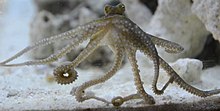
An octopus is a soft-bodied, eight-limbed mollusc of the order Octopoda. The order consists of some 300 species and is grouped within the class Cephalopoda with squids, cuttlefish, and nautiloids. Like other cephalopods, an octopus is bilaterally symmetric with two eyes and a beaked mouth at the center point of the eight limbs. The soft body can radically alter its shape, enabling octopuses to squeeze through small gaps. They trail their eight appendages behind them as they swim. The siphon is used both for respiration and for locomotion, by expelling a jet of water. Octopuses have a complex nervous system and excellent sight, and are among the most intelligent and behaviourally diverse of all invertebrates.

A cephalopod is any member of the molluscan class Cephalopoda such as a squid, octopus, cuttlefish, or nautilus. These exclusively marine animals are characterized by bilateral body symmetry, a prominent head, and a set of arms or tentacles modified from the primitive molluscan foot. Fishers sometimes call cephalopods "inkfish", referring to their common ability to squirt ink. The study of cephalopods is a branch of malacology known as teuthology.

Blue-ringed octopuses, comprising the genus Hapalochlaena, are four extremely venomous species of octopus that are found in tide pools and coral reefs in the Pacific and Indian oceans, from Japan to Australia. They can be identified by their yellowish skin and characteristic blue and black rings that can change color dramatically when the animal is threatened. They eat small crustaceans, including crabs, hermit crabs, shrimp, and other small sea animals.

The blue-lined octopus is one of four species of highly venomous blue-ringed octopuses. It can be found in Pacific Ocean waters that stretch from Australia to Japan. It is most commonly found around intertidal rocky shores and coastal waters to a depth of 15 metres (49 ft) between southern Queensland and southern New South Wales. It is relatively small, with a mantle up to 45 millimetres (1.8 in) in length. In its relaxed state, it is a mottled yellow-brown with dark blue or black streaks covering the whole body apart from the underside of its arms, but its vibrant blue markings appear as a warning to predators when it feels threatened. Along with its other closely related species, the blue-lined octopus is regarded as one of the most dangerous animals in the sea, and its venom can be fatal to humans. This benthic octopus is one of four members of the genus Hapalochlaena, with the other species being the greater blue-ringed octopus, southern blue-ringed octopus, and the blue-ringed octopus. The blue-lined octopus is the only species of the four to display lined iridescent blue marking, as opposed to circular iridescent blue marking that the three other species tend to exhibit.
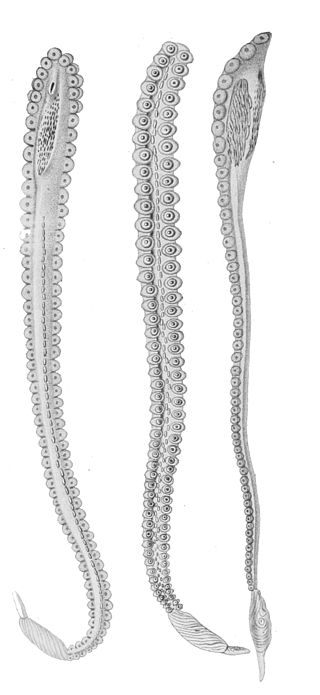
A hectocotylus is one of the arms of male cephalopods that is specialized to store and transfer spermatophores to the female. Structurally, hectocotyli are muscular hydrostats. Depending on the species, the male may use it merely as a conduit to the female, analogously to a penis in other animals, or he may wrench it off and present it to the female.
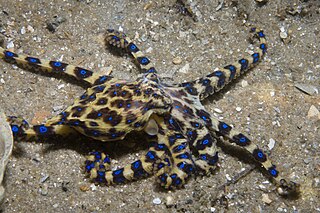
The southern blue-ringed octopus is one of three highly venomous species of blue-ringed octopuses. It is most commonly found in tidal rock pools along the south coast of Australia. As an adult, it can grow up to 20 centimetres (8 in) long and on average weighs 26 grams (0.9 oz). They are normally a docile species, but they are highly venomous, possessing venom capable of killing humans. Their blue rings appear with greater intensity when they become aggravated or threatened.

The greater blue-ringed octopus is one of four species of extremely venomous blue-ringed octopuses belonging to the family Octopodidae. This particular species of blue-ringed octopus is known as one of the most toxic marine animals in the world.

Octopus cyanea, also known as the big blue octopus or day octopus, is an octopus in the family Octopodidae. It occurs in both the Pacific and Indian Oceans, from Hawaii to the eastern coast of Africa. O. cyanea grows to 16 cm in mantle length with arms to at least 80 cm. This octopus was described initially by the British zoologist John Edward Gray in 1849; the type specimen was collected off Australia and is at the Natural History Museum in London.
Abdopus is a genus of octopuses in the family Octopodidae.

Macroctopus maorum is known more commonly as the Maori octopus or the New Zealand octopus. It is found in the waters around New Zealand and southern Australia. M. maorum is one of the largest and most aggressive octopus species living in the New Zealand and Australian waters. They feed mainly on crustaceans and fish. Although they have a short life span, the females lay thousands of eggs and are very protective of them.

Macrotritopus defilippi, commonly known as the Lilliput longarm octopus or the Atlantic longarm octopus, is a small species of octopus, a marine cephalopod mollusc of the order Octopoda.

Octopus tetricus, the gloomy octopus or the common Sydney octopus, is a species of octopus from the subtropical waters of eastern Australia and New Zealand. O.tetricus belongs to the Octopus vulgaris species group and is a commercially prized species. All species within the O. vulgaris group are similar in morphology. The English translation of O. tetricus (Latin) is 'the gloomy octopus'.
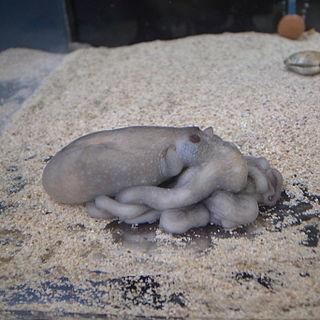
Octopus minor, also known as the long arm octopus or the Korean common octopus, is a small-bodied octopus species distributed along the benthic coastal waters bordering China, Japan, and the Korean Peninsula. It lives at depths ranging from 0 to 200 metres. O. minor is commonly found in the mudflats of sub-tidal zones where it is exposed to significant environmental variation. It is grouped within the class Cephalopoda along with squids and cuttlefish.

Octopus tehuelchus, commonly known as the Patagonian octopus, is a species of octopus, a marine cephalopod mollusc of the order Octopoda. It is native to shallow waters in the subtropical southwestern Atlantic Ocean. It was first described in 1834 by the French naturalist Alcide d'Orbigny.

The larger Pacific striped octopus (LPSO), or Harlequin octopus, is a species of octopus known for its intelligence and gregarious nature. The species was first documented in the 1970s and, being fairly new to scientific observation, has yet to be scientifically described. Because of this, LPSO has no official scientific name. Unlike other octopus species which are normally solitary, the LPSO has been reported as forming groups of up to 40 individuals. While most octopuses are cannibalistic and have to exercise extreme caution while mating, these octopuses mate with their ventral sides touching, pressing their beaks and suckers together in an intimate embrace. The LPSO has presented many behaviors that differ from most species of octopus, including intimate mating behaviors, formation of social communities, unusual hunting behavior, and the ability to reproduce multiple times throughout their life. The LPSO has been found to favor the tropical waters of the Eastern Pacific.

Wunderpus photogenicus, the wunderpus octopus, is a small-bodied species of octopus with distinct white and rusty brown coloration. 'Wunderpus' from German “wunder” meaning ‘marvel or wonder’.

Octopus bimaculatus, commonly referred to as Verill's two-spot octopus, is a similar species to the Octopus bimaculoides, a species it is often mistaken for. The two can be distinguished by the difference in the blue and black chain-like pattern of the ocelli. O. bimaculatus hunt and feed on a diverse number of benthic organisms that also reside off the coast of Southern California. Once the octopus reaches sexual maturity, it shortly dies after mating, which is approximately 12–18 months after hatching. Embryonic development tends to be rapid due to this short lifespan of these organisms.

Octopus insularis is a species of octopus described in 2008 from individuals found off the coast of Brazil, with a potentially much larger range.
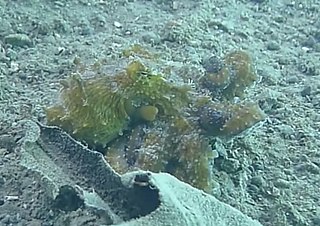
Abdopus abaculus, or the mosaic octopus, is a species of pygmy octopus. It was first described as Octopus abaculus by M. D. Norman and M. J. Sweeney in 1997 based on specimens caught in Zamboanga del Norte, Philippines.
Octopus hubbsorum, is an octopus in the family Octopodidae. It is commonly found along tropical waters along the central Pacific Coast of Mexico.Here, they are one of the most commonly caught cephalopods and are commercially extremely important for the economy.
